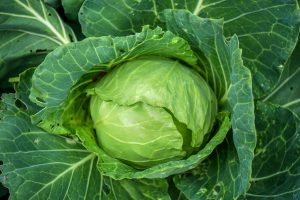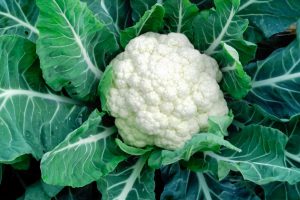Cabbage (Brassica oleracea var. capitata)
Cabbage can be grown in high ranges during winter season. Well-drained sandy loam to clay loam soil is suited for this crop.
Varieties
September, Pusa Drum Head, Golden Acre, Kaveri, Ganga, Sri Ganesh and Pride of India.
Planting requirements
Since it is a cool season crop, sowing is done from August-November. Seed rate is 500-750 g ha-1. Seeds are to be sown in nursery beds. Three to five weeks old seedlings are used for transplanting. Field is prepared by three or four ploughings. Seedlings are transplanted at a spacing of 45 cm x 45 cm.
Manures and fertilizers
Apply 25 t ha-1 FYM or compost. Fertilizer dose is N:P2O5:K2O 150:100: 125 kg ha-1. Apply full dose of P2O5 and half dose of N and K2O before transplanting. Apply remaining half dose one month after transplanting.
Aftercultivation
A continuous supply of moisture is necessary for proper development of heads. Very shallow hoeing should be done to remove weeds and to make the soil better aerated. In order to produce large heads, earth up plants one month after transplanting.
Cauliflower (Brassica oleracea var. botrytis)
Cauliflower can be grown during winter in high ranges. Well-drained sandy loam to clay loam soils are suited for the crop.
Varieties
Pusa Early Synthetic, Pusa Deepali, Early Patna, 74-6-C
Planting requirements
Since it is a cool season crop, sowing is to be done from Aug-Nov. Seed rate is 600-750 g ha-1. Seeds are to be sown in nursery beds. Three to five week old seedlings are used for transplanting. Field is prepared by three or four ploughings. Seedlings are transplanted at a spacing of 60 cm x 45 cm.
Manures and fertilizers
Apply FYM or compost @ 25 t ha-1 and fertilizers @ 150:100:125 N:P2O5:K2O kg ha-1. Apply full dose of P2O5 and half dose of N and K2O before transplanting and remaining N and K one month after transplanting.
After cultivation
A continuous supply of moisture is necessary for proper development of curds. Very shallow hoeing should be done to remove the weeds and to loosen the soil for better aeration. In order to produce large curds, earth up the plant one month after transplanting.
Carrot (Daucus carota)
Carrot can be grown in high ranges from August to January. Well-drained sandy loam soil is best suited for the crop.
Varieties
Pusa Kesar, Nantes, Pusa Meghali
Planting requirements
Seed rate is 5-6 kg ha-1. It is usually sown on ridges to facilitate good root production Ridges of about 20 cm height are made 45 cm apart and seeds sown 10 cm apart on the rows. The seed is mixed with fine sand and sown in rows by hand and covered with soil to make it firm around it.
Manures and fertilizers
Apply 25 t ha-1 FYM before sowing and a fertilizer dose of 37.5 kg N, 62.5 kg P2O5 and 50 kg K2O per ha as basal. Topdressing with 37.5 kg N per ha may be done one month after sowing.
Aftercultivation
It is necessary that enough soil moisture is available to help uniform seed germina-tion and growth of plant. Uproot excess seedlings (thinning) three weeks after sowing leaving a plant to plant spacing of 10 cm to facilitate better tuber growth. Weeding should be done at regular intervals to keep down the weeds. Shallow hoeing is necessary to facilitate root growth. When the root starts growing, earthing up should be done.
Beet Root (Beta vulgaris)
Beet root can be grown in high ranges from August to January. Well-drained sandy loam soils are best suited for the crop.
Varieties: Detroit Dark Red
Planting requirements
Seed rate is 7 to 8 kg ha-1. It is usually grown on ridges to facilitate good root production. Ridges of about 20 cm height are formed 45 cm apart and seeds sown 15-20 cm apart on the rows. The seeds are mixed with fine sand and placed in rows by hand and covered with soil to make it firm around it.
Manures and fertilizers
Apply FYM 20 t ha-1 as basal. N:P2O5: K2O 75:37.5:37.5 kg ha-1 is recommended. Full dose of P2O5 and K2O and half dose of N are applied as basal. Remaining half dose of nitrogen is applied as topdressing when the plant starts growing vigorously.
Aftercultivation
It is necessary that enough soil moisture is available to help uniform seed germination and growth of plant. Thinning the population may be done as in carrot. Weeding should be done at regular intervals to keep down the weeds. Shallow hoeing is necessary to facilitate root growth. When the root starts growing, earthing up should be done.
Radish (Raphanus sativus)
Radish can be grown in high ranges from June to January. Well drained sandy loam soils are best suited for the crop.
Varieties
Japanese White, Arka Nishanth, Pusa Chethki, Pusa Reshmi and Pusa Desi.
Planting requirement
Seed rate is 7 to 8 kg ha-1. It is usually grown on ridges to facilitate good root production. Ridges of about 20 cm height are taken 45 cm apart and plants are grown 10 cm apart on the rows. The seed is mixed with fine sand and sown in rows by hand, covered with soil to make it firm around it.
Manures and fertilizers
Apply 20 t ha-1 FYM as basal. N: P2O5: K2O 75:37.5:37.5 kg ha-1 is the fertilizer requirement. Full dose of P2O5 and K2O and half dose of N are applied as basal. Remaining half dose of nitrogen is applied as topdressing when the plant starts growing vigorously.
After cultivation
It is necessary that enough soil moisture is available to help uniform seed germination and growth of plant. Thinning may be done at 10 cm distance as in carrot. Weeding should be done at regular intervals to keep down weeds. Shallow hoeing is necessary to facilitate root growth. When the roots start growing, earthing up should be done
Potato (Solanum tuberosum)
Potato can be successfully cultivated in the high ranges of Kerala. It is being cultivated in the rain shadow areas of Idukki district throughout the year. A day temperature of 20-30ºC is optimum for growth and tuberisation in potato. Tuber formation is adversely affected, if the temperature goes above 30ºC.
Season
Crops can be raised as shown below in the eastern part of Idukki district.
Summer : March-April
Autumn : August-December
Spring : January-February
Varieties
Among the high yielding varieties, Kufri Jyothi (early), Kufri Muthu (medium), and Kufri Dewa (late) can be tried in the high ranges of Kerala.
Soil
Loose friable sandy loam or silt loam, rich in organic matter are ideal for potato. Hard clay should be avoided. Optimum pH range is 5.2-7.0
Planting
Whole potato tuber or cut pieces (50-60 g size) longitudinally cut from bud-end to stem end can be used for plating. For planting 1 ha, 1000-2000 kg seed tubers are required. Seed tubers are treated with 1 ppm of GA 3 for one hour and then dried in shade for getting uniform sprouting. Tubers are filled in gunny bags after drying and kept in vertical position in well-ventilated dark room for 10 days for encouraging sprouting. Seed pieces should be treated with mancozeb (@ 1 kg in 450 litres of water) before planting to protect them from soil borne diseases. Tubers can be planted on ridges 50-60 cm wide at a spacing of 15-20 cm between the plants. Earthing up is needed during the growing phase (30 days after planting) and 70 days after planting.
Manuring
A basal application of FYM (20 t ha-1) is required during field preparation. Apply 60 kg N, 100 kg P2O5 and 120 kg K2O as basal. Top dressing with 60 kg N, 30 days after planting at the time of first earthing up is essential.
Plant protection
Early blight and late blight are the important fungal diseases. Spraying zineb (2 g per litre of water) is effective to control early blight. Copper fungicides can control late blight. Cut worms, aphids and jassids are common pests of potato. Dusting with carbaryl 10 per cent DP immediately after planting can control cut worms. Spraying carbaryl 0.2 per cent controls leaf eating caterpillars. To control aphids and jassids spraying dimethoate (0.05 per cent) is effective.
Garlic (Allium sativum)
Garlic requires cool and moist period during vegetative growth and a dry spell during maturity of the bulbs. Fertile, well-drained loamy soils are ideal for garlic cultivation. Heavy clay soils may result in deformed bulbs. In high ranges of Kerala garlic can be planted during October- November.
Varieties: Ooty-1, G 50
Planting requirements
Cloves or bulbils are used for propagation. For planting one hectare, 500 kg of cloves is required. The cloves for planting should be stored for 2-3 months after harvest and cloves weighing 4 g are ideal for planting. The cloves should be soaked in water followed by dipping for 15 minutes in a solution containing and 1 g of carbendazim dissolved in 1 litre of water for 15 minutes. After drying in shade, cloves can be used for planting. Dig the land thoroughly and prepare beds of 15 cm height at a width of 1 m and of convenient length. The cloves should be dibbled at a spacing of 15 cm x 8 cm. Germination will start on the fifth day and it will be completed within 10-15 days.
Manuring
Apply N:P2O5: K2O @ 60:120:120 kg ha-1 20 days after transplanting (DAP). Top dressing of N should be done @ 60 kg ha-1, 45 DAP.
Aftercultivation
Earthing up should be done 60 DAP
Plant protection
To control blast, spray mancozeb (2 g l-1)
Harvest
Harvesting can be done 120-130 DAP. Yield may vary from 5-10 t ha-1.